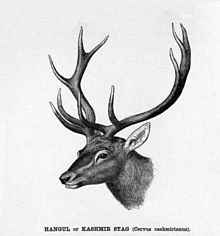- Kashmir stag
-
Kashmir Stag 
Scientific classification Kingdom: Animalia Phylum: Chordata Class: Mammalia Order: Artiodactyla Suborder: Ruminantia Family: Cervidae Subfamily: Cervinae Genus: Cervus Species: C. elaphus Subspecies: C. e. hanglu Trinomial name Cervus elaphus hanglu The Kashmir stag (Cervus elaphus hanglu), also called hangul, is a subspecies of Red Deer native to northern Pakistan and India, especially in Jammu and Kashmir where it is the state animal.
Contents
Description
This deer has a light rump patch without including the tail. Its coat color is brown with a speckling to the hairs. The inner sides of the buttocks are grayish white, followed by a line on the inner sides of the thighs and black on the upper side of the tail. Each antler consists of five tines. The beam is strongly curved inward, while the brow and bez tines are usually close together and above the burr.
Distribution and ecology
This deer lives in groups of two to 18 individuals in dense riverine forests, high valleys, and mountains of the Kashmir valley and northern Chamba in Himachal Pradesh. In Kashmir, it's found in Dachigam National Park at elevations of 3,035 meters.
Threats and conservation
These deer once numbered from about 5,000 animals in the beginning of the 20th century. Unfortunately, they were threatened, due to habitat destruction, over-grazing by domestic livestock, and poaching. This dwindled to as low as 150 animals by 1970. However, the state of Jammu & Kashmir, along with the IUCN and the WWF prepared a project for the protection of these animals. It became known as Project Hangul. This brought great results and the population increased to over 340 by 1980.
Much of the earlier published material was by the distinguished E. P. Gee, a member of the Bombay Natural History Society. Shortly before the expedition was mounted, Fiona Guinness and Tim Clutton-Brock, both noted deer experts, had visited Kashmir and had gathered some useful field data, which confirmed that Hangul numbers were at a dangerously low level.
Scientifically known as Cervus elaphus hanglu, Hangul is the only surviving race of the Red Deer family of Europe in the sub-continent. The animal is battling for its survival in its last bastion: they are now scattered within 141 km² of the Dachigam National Park located on foothills of Zabarwan range on the outskirts of Srinagar. Known for its magnificent antlers with 11 to 16 points, hangul was once distributed widely in the mountains of Kashmir. During 1940's, their number was believed to be about 3,000-5,000. As per the latest census in 2008, only around 160 exist. There are plans to breed them in captivity to increase their chances of survival[1]
References
External links
- Rare Kashmiri deer on verge of extinction, 12 May, 2008, REUTERS; The Economic Times, Times of India
- Endangered Hangul spotted in many parts of Kashmir, 5 May 2008, PTI, Times of India
- Wildlife institute wants larger area for Hangul deer, April 09, 2008, Aditya V Singh, The Indian Express
- Deer Specialist Group 1996. Cervus elaphus ssp. hanglu. In: IUCN 2007. 2007 IUCN Red List of Threatened Species. <www.iucnredlist.org>. Downloaded on 19 May 2008. IUCN Red List status of Endangered is outdated, Kashmir Stag is a Critically Endangered as numbers have fallen to below 200 individuals as of 2008.
Categories:- Elk and Red Deer
- Fauna of Jammu and Kashmir
- Mammals of Pakistan
Wikimedia Foundation. 2010.
